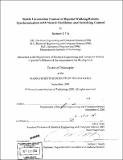| dc.contributor.advisor | Gill A. Pratt. | en_US |
| dc.contributor.author | Hu, Jianjuen, 1964- | en_US |
| dc.contributor.other | Massachusetts Institute of Technology. Dept. of Electrical Engineering and Computer Science. | en_US |
| dc.date.accessioned | 2005-08-23T15:25:41Z | |
| dc.date.available | 2005-08-23T15:25:41Z | |
| dc.date.copyright | 2000 | en_US |
| dc.date.issued | 2000 | en_US |
| dc.identifier.uri | http://hdl.handle.net/1721.1/8799 | |
| dc.description | Thesis (Ph.D.)--Massachusetts Institute of Technology, Dept. of Electrical Engineering and Computer Science, 2000. | en_US |
| dc.description | Includes bibliographical references (leaves 105-110). | en_US |
| dc.description.abstract | Two novel approaches to stable legged locomotion control (neural-oscillator based control and switching control) are studied for achieving bipedal locomotion stability. Postural stability is realized by structural dynamics shaping, and gait stability is achieved by synchronization with neural oscillators and switching control. A biologically inspired control with neural oscillators (central pattern generator, abbreviated as CPG) is used for global stable locomotion of bipeds based on a mutually inhibited neural oscillator model (Matsuoka, 1985). A systematic design approach is studied for the entrainment between the dynamics of neural oscillators and the natural dynamics of the plant (bipedal skeletal dynamics) in the neural oscillator driven rhythmic control. This design can guarantee global dynamic entrainment, bipedal gait stability and system robustness, which are explored and analyzed using nonlinear system theories. The second control approach, called nonlinear switching control, is proposed to achieve stable locomotion control for a bipedal walking robot. This approach applies nonlinear switching control theory in the locomotion control system so as to ensure bipedal gait stability in the stable limit cycle sense. The switching surface is determined by means of the orbital contraction tuning technique. Both the structural dynamics stability and gait stability are analyzed. The convergence of the walking gait is proved based on nonlinear system theory. Two common features for the above control approaches are that a global state machine based switching module and a closed-loop gait stabilization mechanism are used in both control systems. In neural oscillator driven locomotion control, the sensory feedback signals are switched according to the states of global state machine. However, in the switching control, the global state machine is used to select the appropriate control sub-systems in addition to a contraction tuning mechanism. In both approaches, an explicit closed-loop gait control mechanism is implemented to guarantee the bipedal gait stability. Simulations of 2-D and 3-D bipedal walking robots demonstrate the effectiveness of the above locomotion control approaches. Different simulated experiments are given in the system analysis and evaluations. It has been shown that the above two bipedal locomotion control approaches can be further applied in the real-time control of bipedal walking robotic systems with proper locomotion stability and robustness. | en_US |
| dc.description.statementofresponsibility | by Jianjuen J. Hu. | en_US |
| dc.format.extent | 110 leaves | en_US |
| dc.format.extent | 8184659 bytes | |
| dc.format.extent | 8184419 bytes | |
| dc.format.mimetype | application/pdf | |
| dc.format.mimetype | application/pdf | |
| dc.language.iso | eng | en_US |
| dc.publisher | Massachusetts Institute of Technology | en_US |
| dc.rights | M.I.T. theses are protected by copyright. They may be viewed from this source for any purpose, but reproduction or distribution in any format is prohibited without written permission. See provided URL for inquiries about permission. | en_US |
| dc.rights.uri | http://dspace.mit.edu/handle/1721.1/7582 | |
| dc.subject | Electrical Engineering and Computer Science. | en_US |
| dc.title | Stable locomotion control of bipedal walking robots : synchronization with neural oscillators and switching control | en_US |
| dc.type | Thesis | en_US |
| dc.description.degree | Ph.D. | en_US |
| dc.contributor.department | Massachusetts Institute of Technology. Department of Electrical Engineering and Computer Science | |
| dc.identifier.oclc | 48228217 | en_US |
